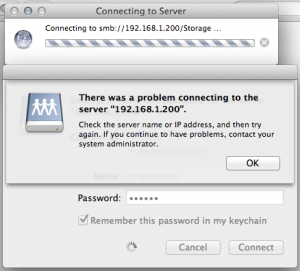Posts Tagged Samba
Samba vs NFS on DNS-323
So far, I was using Samba to share the files stored on my D-Link DNS-323. However, people tend to say that NFS is quicker than Samba. So let’s benchmark those two protocols and figure out which one is actually quicker.
First of all, here is my configuration:
| Server | Client |
|---|---|
|
D-Link DNS-323 Linux dlink-5610E5 2.6.12.6-arm1 Samba 3.0.24 UNFS3 0.9.20 |
Raspberry Pi Linux alarmpi 3.6.11-15-ARCH+ CIFS utils 6.1-1 NFS utils 1.2.8-9 |
I used IOzone to benchmark these protocols from the Raspberry Pi. You can find the package for Arch Linux ARM on one of my previous post.
I first mounted the Samba and NFS share drives in the two respective folders /mnt/storage_smb and /mnt/storage_nfs.
I then ran the following commands (not at the same time):
iozone -RazcR -U /mnt/storage_smb -f /mnt/storage_smb/testfile -b smb_excel_output.xls iozone -RazcR -U /mnt/storage_nfs -f /mnt/storage_nfs/testfile -b nfs_excel_output.xls
You can download the output files here and here.
Or, you can simply have a look at a summary of these two files in the following table which basically compare the average speed (in Kbytes per second) for both Samba and NFS:
| Samba | NFS | |
|---|---|---|
| Write | 7683 | 6676 |
| Re-write | 7544 | 6795 |
| Read | 21862 | 50464 |
| Re-read | 22383 | 50210 |
| Random read | 6348 | 6444 |
| Random write | 7603 | 6751 |
| Backward read | 5909 | 5246 |
| Record rewrite | 80294 | 87225 |
| Stride read | 15629 | 11868 |
| Fwrite | 7471 | 6700 |
| Re-fwrite | 7494 | 6671 |
| Fread | 7739 | 7685 |
| Re-fread | 7596 | 7639 |
As you can see, it looks like NFS is quicker for read operations but slower for write operations than Samba. But please remember that this is true for this very specific configuration ; It could be completely different for another one.
In conclusion, I personally decided to use both Samba and NFS depending of what I need. If I need a read only access to my data, I use NFS. However, if I need to write data, I use Samba.
NB: Another reason why I didn’t completely stop using Samba is because symbolic links don’t work with NFS. Instead, you need to use binding (mounting a folder inside another folder), but this is kind of incompatible with my use of rsync to backup my data. 🙁
Samba access problem with Mac OS X 10.6+
This is a problem I encountered when I upgraded Mac OS X from the version 10.5 (Leopard) to 10.6 (Snow Leopard). One of my friend also got a similar problem when she upgraded to the version 10.7 (Lion).
This issue was affecting the access to the network shares set up with Samba (version 3.0.24) on my D-Link DNS-323. For some reason, I wasn’t able to authenticate on the shares as soon as I upgraded to Snow Leopard!
Here is the error message I was getting:

After browsing a few forums on the web, I finally found a solution. 🙂
I simply had to change the security mode in the Samba configuration file (smb.conf) to read:
security = USER
Note that this property can be found under the [global] section.
For more information about the Samba security mode, please read the following article by Jack Wallen:
Understanding Samba security modes

